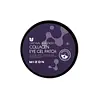What's inside
What's inside
 Key Ingredients
Key Ingredients

 Benefits
Benefits

 Concerns
Concerns

 Ingredients Side-by-side
Ingredients Side-by-side

Water
Skin ConditioningGlycerin
HumectantChondrus Crispus Extract
Skin ConditioningCeratonia Siliqua Gum
EmollientCellulose Gum
Emulsion StabilisingHydroxyacetophenone
Antioxidant1,2-Hexanediol
Skin ConditioningSucrose
HumectantPotassium Chloride
Allantoin
Skin ConditioningXanthan Gum
EmulsifyingEthylhexylglycerin
Skin ConditioningCalcium Aluminum Borosilicate
CI 77007
Cosmetic ColorantAdenosine
Skin ConditioningBis-PEG-15 Methyl Ether Dimethicone
EmulsifyingDisodium EDTA
Calcium Lactate
AstringentCI 77891
Cosmetic ColorantSilica
AbrasiveMica
Cosmetic ColorantHydrolyzed Collagen
EmollientDipotassium Glycyrrhizate
HumectantSodium Polyacryloyldimethyl Taurate
Emulsion StabilisingPolyglyceryl-4 Caprate
EmulsifyingPolyglyceryl-6 Caprylate
EmulsifyingDipalmitoyl Hydroxyproline
Skin ConditioningPEG-60 Hydrogenated Castor Oil
EmulsifyingButylene Glycol
HumectantPalmitic Acid
EmollientParfum
MaskingPortulaca Oleracea Extract
Skin ConditioningChamomilla Recutita Flower Extract
MaskingCaviar Extract
Skin ConditioningPhenoxyethanol
PreservativeTocopherol
AntioxidantWater, Glycerin, Chondrus Crispus Extract, Ceratonia Siliqua Gum, Cellulose Gum, Hydroxyacetophenone, 1,2-Hexanediol, Sucrose, Potassium Chloride, Allantoin, Xanthan Gum, Ethylhexylglycerin, Calcium Aluminum Borosilicate, CI 77007, Adenosine, Bis-PEG-15 Methyl Ether Dimethicone, Disodium EDTA, Calcium Lactate, CI 77891, Silica, Mica, Hydrolyzed Collagen, Dipotassium Glycyrrhizate, Sodium Polyacryloyldimethyl Taurate, Polyglyceryl-4 Caprate, Polyglyceryl-6 Caprylate, Dipalmitoyl Hydroxyproline, PEG-60 Hydrogenated Castor Oil, Butylene Glycol, Palmitic Acid, Parfum, Portulaca Oleracea Extract, Chamomilla Recutita Flower Extract, Caviar Extract, Phenoxyethanol, Tocopherol
Snail Secretion Filtrate
Skin ConditioningButylene Glycol
HumectantGlycerin
HumectantHelianthus Annuus Seed Oil
Emollient1,2-Hexanediol
Skin ConditioningNiacinamide
SmoothingWater
Skin ConditioningPalmitic Acid
EmollientArginine
MaskingCarbomer
Emulsion StabilisingStearic Acid
CleansingBetaine
HumectantCetearyl Olivate
Sorbitan Olivate
EmulsifyingSodium Polyacrylate
AbsorbentAllantoin
Skin ConditioningTocopheryl Acetate
AntioxidantPanthenol
Skin ConditioningHydroxyethyl Acrylate/Sodium Acryloyldimethyl Taurate Copolymer
Emulsion StabilisingSodium Hyaluronate
HumectantAdenosine
Skin ConditioningXanthan Gum
EmulsifyingMyristic Acid
CleansingCopper Tripeptide-1
Skin ConditioningAcetyl Hexapeptide-8
HumectantPalmitoyl Pentapeptide-4
Skin ConditioningPalmitoyl Tripeptide-1
Skin ConditioningPalmitoyl Tetrapeptide-7
Skin ConditioningSnail Secretion Filtrate, Butylene Glycol, Glycerin, Helianthus Annuus Seed Oil, 1,2-Hexanediol, Niacinamide, Water, Palmitic Acid, Arginine, Carbomer, Stearic Acid, Betaine, Cetearyl Olivate, Sorbitan Olivate, Sodium Polyacrylate, Allantoin, Tocopheryl Acetate, Panthenol, Hydroxyethyl Acrylate/Sodium Acryloyldimethyl Taurate Copolymer, Sodium Hyaluronate, Adenosine, Xanthan Gum, Myristic Acid, Copper Tripeptide-1, Acetyl Hexapeptide-8, Palmitoyl Pentapeptide-4, Palmitoyl Tripeptide-1, Palmitoyl Tetrapeptide-7
 Reviews
Reviews

Ingredients Explained
These ingredients are found in both products.
Ingredients higher up in an ingredient list are typically present in a larger amount.
1,2-Hexanediol is a synthetic liquid and another multi-functional powerhouse.
It is a:
- Humectant, drawing moisture into the skin
- Emollient, helping to soften skin
- Solvent, dispersing and stabilizing formulas
- Preservative booster, enhancing the antimicrobial activity of other preservatives
Adenosine is in every living organism. It is one of four components in nucleic acids that helps store our DNA.
Adenosine has many benefits when used. These benefits include hydrating the skin, smoothing skin, and reducing wrinkles. Once applied, adenosine increases collagen production. It also helps with improving firmness and tissue repair.
Studies have found adenosine may also help with wound healing.
In skincare products, Adenosine is usually derived from yeast.
Learn more about AdenosineAllantoin is a soothing ingredient known for its protective and moisturizingg properties. Because of this, it is often added to products with strong active ingredients.
Studies show higher concentrations of this ingredient can promote wound healing.
Though it can be derived from the comfrey plant, allantoin is produced synthetically for cosmetic products to ensure purity.
Learn more about AllantoinButylene Glycol (or BG) is used within cosmetic products for a few different reasons:
Overall, Butylene Glycol is a safe and well-rounded ingredient that works well with other ingredients.
Though this ingredient works well with most skin types, some people with sensitive skin may experience a reaction such as allergic rashes, closed comedones, or itchiness.
Learn more about Butylene GlycolGlycerin is already naturally found in your skin. It helps moisturize and protect your skin.
A study from 2016 found glycerin to be more effective as a humectant than AHAs and hyaluronic acid.
As a humectant, it helps the skin stay hydrated by pulling moisture to your skin. The low molecular weight of glycerin allows it to pull moisture into the deeper layers of your skin.
Hydrated skin improves your skin barrier; Your skin barrier helps protect against irritants and bacteria.
Glycerin has also been found to have antimicrobial and antiviral properties. Due to these properties, glycerin is often used in wound and burn treatments.
In cosmetics, glycerin is usually derived from plants such as soybean or palm. However, it can also be sourced from animals, such as tallow or animal fat.
This ingredient is organic, colorless, odorless, and non-toxic.
Glycerin is the name for this ingredient in American English. British English uses Glycerol/Glycerine.
Learn more about GlycerinPalmitic Acid is a fatty acid naturally found in our skin and in many plant and animal sources. In cosmetics, it is usually derived from palm oil. It serves many purposes in skincare, acting as a cleanser, emollient, and emulsifier.
As an emollient, palmitic acid helps soften and smooth the skin by preventing water loss. In cleansers, it helps remove oil and dirt while creating foam.
Its emulsifying properties help stabilize products by keeping water and oil-based ingredients from separating.
This may not be suitable for fungal acne-prone skin, as fatty acids like this can sometimes trigger breakouts in sensitive individuals.
Learn more about Palmitic AcidWater. It's the most common cosmetic ingredient of all. You'll usually see it at the top of ingredient lists, meaning that it makes up the largest part of the product.
So why is it so popular? Water most often acts as a solvent - this means that it helps dissolve other ingredients into the formulation.
You'll also recognize water as that liquid we all need to stay alive. If you see this, drink a glass of water. Stay hydrated!
Learn more about WaterXanthan gum is used as a stabilizer and thickener within cosmetic products. It helps give products a sticky, thick feeling - preventing them from being too runny.
On the technical side of things, xanthan gum is a polysaccharide - a combination consisting of multiple sugar molecules bonded together.
Xanthan gum is a pretty common and great ingredient. It is a natural, non-toxic, non-irritating ingredient that is also commonly used in food products.
Learn more about Xanthan Gum